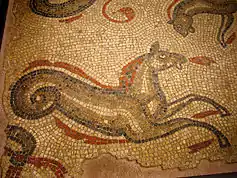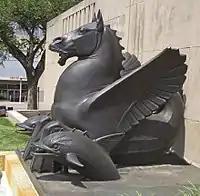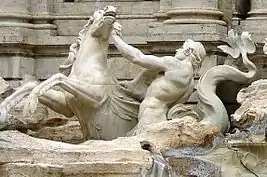馬頭魚尾怪
馬頭魚尾怪(希臘語:,來自——馬,及——怪物[1]的結合)在英文中常稱作海馬(sea-horse)[2],雖然現在只有希臘名稱,但實際上它是同時出現在腓尼基[3] 和希臘神話中的一種生物。這種生物後來被吸納入伊特魯里亞神話中。一般被描述為後半身是蜷曲的有鱗魚的馬狀生物。
_-_Arion_on_a_Sea_Horse_(1855).jpg.webp)
威廉·阿道夫·布格羅,《海馬身上的阿里翁》(1855)
神話學

羅馬公共浴場中的鑲嵌畫,巴斯
希臘和羅馬

堪薩斯城裝飾風藝術噴泉上的有翼馬頭魚尾怪,1937年
在荷馬的《伊利亞特》中,荷馬曾描述波塞冬由黃銅蹄子的馬拉著在海面上奔馳的場景,[5] 羅德島的阿波羅尼烏斯和瓦萊里烏斯·弗拉庫斯也曾描過繪類似的場景。[6][7] 在希臘化時代和羅馬帝國時,拉馬車者便變成了馬頭魚尾怪,在之後的許多藝術作品中,馬頭魚尾怪和波塞冬一起出現的形象也屢見不鮮。
亞加亞附近赫里克的一座神廟是供奉波塞冬的,[8] 據說當這座城市被洪水淹沒時,其上波塞冬與馬頭魚尾怪的銅像拖住了漁夫的漁網。[9] 科林斯曾有一座鍍金青銅和象牙做成的雕像被認為是馬頭魚尾怪。[10] 在羅馬帝國的許多公共浴場都有馬頭魚尾怪的鑲嵌畫。
參考文獻
- Word origin of Hippocampus at reference.com; compare the nameless monster Campe.
- The hyphen distinguishes from the seahorse, a real fish.
- Israel Antiquities Authority, Yizre'el Valley silver hoard (retrieved Jan 10 2013)
- Sharon Waxman, Loot: The Battle over the Stolen Treasures of the Ancient World, Chapter 6; excerpt in Smithsonian 的存檔,存档日期2008-12-10., Nov. 14, 2008 (retrieved Jan 10 2013).
- Homer, Iliad xlii. 24, 29;
- Apollonius of Rhodes, Argonautica (iv.1353ff)
- Valerius Flaccus, Argonautica 2.507.
- Strabo: "The sea was raised by an earthquake and it submerged Helike and also the temple of Poseidon Helikonios..." (Geography 8.7.2).
- According to Eratosthenes, noted by Strabo (loc. cit.).
- Geography of Greece ii.1.7-.8
- Etruscan sea creatures, including a range of hippocampi, are set in cultural context and ordered by typology in Monika Boosen, Etruskische Meeresmischwesen: Untersuchungen zur Typologie u. Bedeutung (Archaeologica 59) (Rome:Bretschneider) 1986.
- Katharine Shepard, The Fish-Tailed Monster in Greek and Etruscan Art, 1940, pp 25ff; the thesis was, exceptionally, reviewed (by G.W. Elderkin) in American Journal of Archaeology 45.2 (April 1941), pp. 307-308: available on-line through JSTOR.
- Nigella Hillgarth, Birch Aquarium at Scripps Institute of Oceanography, in Myth, Legend & Art Archive.is的存檔,存档日期2013-02-17, January 8th, 2010 (retrieved Jan 10, 2013)
- Fox-Davies, Arthur Charles. Complete Guide to Heraldry, 1978.
- Classical references: Homer, Iliad xlii. 24, 29; Euripides, Andromache 1012; Virgil Georgics iv. 389; Philostratus Imagines i. 8; Statius Thebaid ii. 45 and Achilleid 1.25.
This article is issued from Wikipedia. The text is licensed under Creative Commons - Attribution - Sharealike. Additional terms may apply for the media files.
